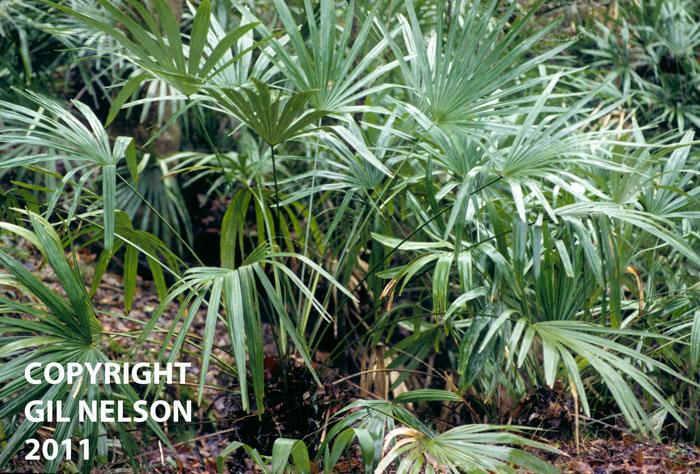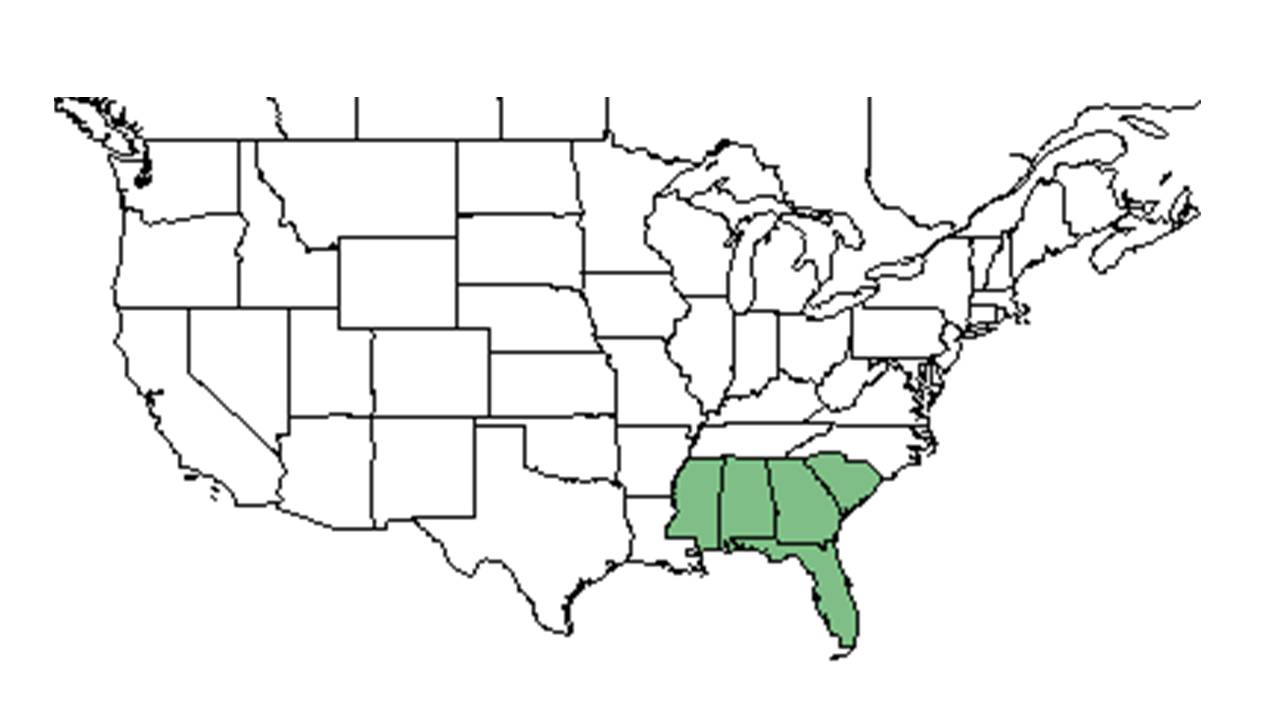Difference between revisions of "Rhapidophyllum hystrix"
(→Conservation and Management) |
Krobertson (talk | contribs) |
||
| Line 22: | Line 22: | ||
==Description== | ==Description== | ||
<!-- Basic life history facts such as annual/perrenial, monoecious/dioecious, root morphology, seed type, etc. --> | <!-- Basic life history facts such as annual/perrenial, monoecious/dioecious, root morphology, seed type, etc. --> | ||
| − | A description of ''Rhapidophyllum hystrix'' is provided in [http://efloras.org/florataxon.aspx?flora_id=1&taxon_id=220011536 The Flora of North America]. ''Rhapidophyllum hystrix'' is a perennial shrub with needles at the base of its leaves | + | A description of ''Rhapidophyllum hystrix'' is provided in [http://efloras.org/florataxon.aspx?flora_id=1&taxon_id=220011536 The Flora of North America]. ''Rhapidophyllum hystrix'' is a perennial shrub with needles at the base of its leaves. <ref name="FSU Herbarium">Florida State University Robert K. Godfrey Herbarium database. URL: [http://herbarium.bio.fsu.edu http://herbarium.bio.fsu.edu]. Last accessed: June 2014. Collectors: Loran C. Anderson, Robert K. Godfrey, Lisa Keppner, Angus Gholson, James R. Burkhalter, R. Kral, Gary R. Knight, Mark Garland, Sidney McDaniel, Richard D. Houk, L.B. Thein, S.D. Latimer, Patricia Elliot, George R. Cooley, Carroll E. Wood, Jr., Kenneth A. Wilson, Leonard J. Brass, R.S. Mitchell, and A.F. Clewell. States and Counties: Florida: Citrus, Clay, Escambia, Gadsden, Jackson, Jefferson, Lake, Leon, Liberty, Okaloosa, Santa Rosa, Taylor, Wakulla, and Washington. Georgia: Clay and Grady. Alabama: Baldwin.</ref> |
==Distribution== | ==Distribution== | ||
==Ecology== | ==Ecology== | ||
===Habitat=== <!--Natural communities, human disturbed habitats, topography, hydrology, soils, light, fire regime requirements for removal of competition, etc.--> | ===Habitat=== <!--Natural communities, human disturbed habitats, topography, hydrology, soils, light, fire regime requirements for removal of competition, etc.--> | ||
| − | ''R. hystrix'' occurs most frequently in shaded wet sandy or loamy soil | + | ''R. hystrix'' occurs most frequently in shaded wet sandy or loamy soil. <ref name="FSU Herbarium"/> It can be found in floodplains, as well as on the slopes of steephead ravines and on limestone outcrops. <ref name="FSU Herbarium"/> It appears in several native community types, including mixed hardwood woodlands, Magnolia-Tilia-Hydrangea bluffs, and cabbage palm-hardwood hammocks. <ref name="FSU Herbarium"/> It can also occasionally be found in disturbed areas like roadsides. <ref name="FSU Herbarium"/> Associated species include ''Sabal minor, Magnolia virginiana, Hydrangea quercifolia, Sabal palmetto,'' and ''Gordonia lasianthus.'' <ref name="FSU Herbarium"/> |
===Phenology=== <!--Timing off flowering, fruiting, seed dispersal, and environmental triggers. Cite PanFlora website if appropriate: http://www.gilnelson.com/PanFlora/ --> | ===Phenology=== <!--Timing off flowering, fruiting, seed dispersal, and environmental triggers. Cite PanFlora website if appropriate: http://www.gilnelson.com/PanFlora/ --> | ||
| − | Flowering has been observed in February and May, while fruiting has been observed in February and August | + | Flowering has been observed in February and May, while fruiting has been observed in February and August. <ref name="FSU Herbarium"/> |
| + | |||
<!--===Seed dispersal===--> | <!--===Seed dispersal===--> | ||
<!--===Seed bank and germination===--> | <!--===Seed bank and germination===--> | ||
| Line 46: | Line 47: | ||
==References and notes== | ==References and notes== | ||
| − | |||
Revision as of 10:30, 8 August 2016
| Rhapidophyllum hystrix | |
|---|---|

| |
| Photo taken by Gil Nelson | |
| Scientific classification | |
| Kingdom: | Plantae |
| Division: | Magnoliophyta – Flowering plants |
| Class: | Liliopsida – Monocotyledons |
| Order: | Arecales |
| Family: | Arecaceae ⁄ Palmae |
| Genus: | Rhapidophyllum |
| Species: | R. hystrix |
| Binomial name | |
| Rhapidophyllum hystrix (Pursh) H. Wendl. & Drude ex Drude | |

| |
| Natural range of Rhapidophyllum hystrix from USDA NRCS Plants Database. | |
Common name: Needle palm
Contents
Taxonomic notes
Description
A description of Rhapidophyllum hystrix is provided in The Flora of North America. Rhapidophyllum hystrix is a perennial shrub with needles at the base of its leaves. [1]
Distribution
Ecology
Habitat
R. hystrix occurs most frequently in shaded wet sandy or loamy soil. [1] It can be found in floodplains, as well as on the slopes of steephead ravines and on limestone outcrops. [1] It appears in several native community types, including mixed hardwood woodlands, Magnolia-Tilia-Hydrangea bluffs, and cabbage palm-hardwood hammocks. [1] It can also occasionally be found in disturbed areas like roadsides. [1] Associated species include Sabal minor, Magnolia virginiana, Hydrangea quercifolia, Sabal palmetto, and Gordonia lasianthus. [1]
Phenology
Flowering has been observed in February and May, while fruiting has been observed in February and August. [1]
Conservation and management
Cultivation and restoration
Photo Gallery
References and notes
- ↑ 1.0 1.1 1.2 1.3 1.4 1.5 1.6 Florida State University Robert K. Godfrey Herbarium database. URL: http://herbarium.bio.fsu.edu. Last accessed: June 2014. Collectors: Loran C. Anderson, Robert K. Godfrey, Lisa Keppner, Angus Gholson, James R. Burkhalter, R. Kral, Gary R. Knight, Mark Garland, Sidney McDaniel, Richard D. Houk, L.B. Thein, S.D. Latimer, Patricia Elliot, George R. Cooley, Carroll E. Wood, Jr., Kenneth A. Wilson, Leonard J. Brass, R.S. Mitchell, and A.F. Clewell. States and Counties: Florida: Citrus, Clay, Escambia, Gadsden, Jackson, Jefferson, Lake, Leon, Liberty, Okaloosa, Santa Rosa, Taylor, Wakulla, and Washington. Georgia: Clay and Grady. Alabama: Baldwin.